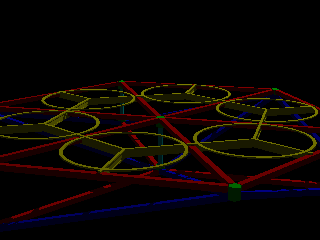The design of the mini-heliostat arrays has been changed somewhat during the past six months. These pictures have been sitting around since this summer and it is time that I do something with them.
Since some of the pictures are rather large, thumbnails will be presented first. If you want more detail, click on the thumbnail and the bigger picture will load.
The field in these pictures consists of 48 arrays of 6 mini-heliostats each (288 mirrors total) arranged on hexagonal frames (not shown, but see below). Since the mirrors are 30 cm by 30 cm, this gives a maximum total flux of about 25 kW of solar energy (assuming a direct insolation of 1 kW/m2 and ignoring cosine factors.)
A human figure has been added to the pictures to give a sense of scale.
In the center of the field is a 4 meter receiver tower made of metal with a 1 meter high, 60 cm diameter steam boiler on top. The boiler could be a recycled high pressure gas bottle or a coil of steel tubing. The boiler is white due to the concentrated solar radiation falling on it. The sun is at an elevation of 45° and an azimuth of 45° and the mirrors are all angled to reflect the light to the center of the boiler.

|
| PNG 21k |
The picture above gives an approximate idea of what the hexagonal support structure of each array will look like. Note that it will not be multi-coloured. This frame is mostly composed of hollow square (or round) plastic tubes, about 1.5 cm in width with a wall thickness of 1 mm. The largest pieces are 80 cm long and the array is 160 cm across in its largest dimension. The combination of the frame plus the plastic heliostats should weigh about 1 kg.
These tubes are fastened together with specially molded junction pieces that allow one to snap the structure together - no screws are needed. The result is a strong but extremely light-weight structure to which the heliostats, gear trains, and motor units can be attached. Assembly is simple enough that even a youngster with average intelligence and dexterity could put together many structures in an hour.
Array assembly can take place near the field or far away. In either case, transport is a one-man job since the heliostats and their supports are so light-weight. A normal adult could easily carry two assembled arrays at a time or possibly four, if he was careful.
This ease of transport could important for protecting the heliostats from storms or other natural disasters. It also permits use in cases where land is only temporarily available, for example in fields that farmers have left fallow for a couple of years.
The arrays are placed on relatively smooth ground surrounding the central tower. Each array has three legs (not shown above) that allow the array to rest perfectly stable on the ground without any preparation. If wind is a problem, the legs have holes in their feet that allow one to secure the leg with a spike driven into the ground.
After all of the arrays are placed, their motor units are hooked up to one or more shared controllers and the field is calibrated.
If the field is small, the calibration procedure is done semi-automatically during the day by adjusting two mirrors from each array with a "teaching wand" (a remote-control joystick that is interfaced with the controller computers) to reflect the sunlight to a calibration target. If the field is large, the calibration procedure is done automatically at night with a computer-guided laser and a computer vision system.
The software (POVRAY) used to render these pictures is described in the previous page of renderings.
--
Erik Rossen <rossen@rossen.ch>Copyright © 2000 until the heat-death of the Universe (thanks, Mickey!), by Erik Rossen
Last modified: 2016-02-07T12:43:24+0100
HOME -> SOLAR + HELIOSTATS -> HEXAGONAL HELIOSTAT SUPPORT | SITEMAP